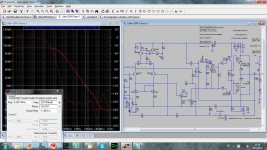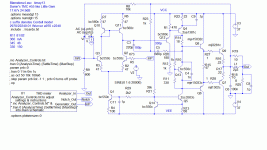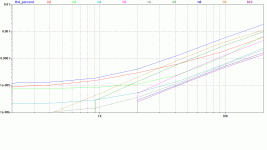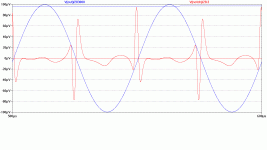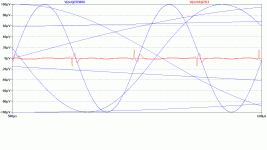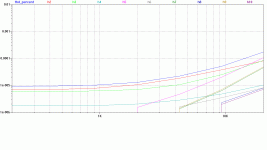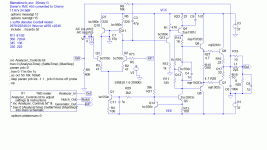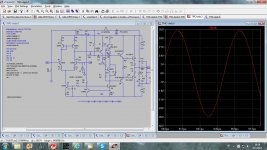Lastly, I hope everyone knows that when I say 'evil', it is tongue-in-cheek (ie a joke). I don't really think triples evil (actually I do ... but not for the reasons discussed here) ... but that you can get similar or better performance using simpler circuits.

You have your opinion about triples, I've had my doubts if triples are realy needed.
http://www.diyaudio.com/forums/solid-state/221901-little-gem.html
BR Damir
Michael, your .ASCs dun count cos Cherry, myself (& 'real life') are convinced they will be unstable. We agree that your circuits will be unstable .. because of the design choices .. evil triples + enhanced VAS, no VAS emitter resistor, other evil stuff .. . Why use an example that is known to be wonky (according to Cherry & others and 'real life') to criticise 'pure Cherry'?
The point I made earlier is that Cherry never placed any caveats on the use of OIC in respect of output triples or "enhanced VAS". The only recommendations he made were:
1) Use degeneration for the second stage, which doesn't work, and
2) Use relatively small (~33pF) capacitors across the base-collector junctions of the drivers. This basically amounts to shunt compensation of the second stage, and, anyway, doesn't work unless the shunt capacitance is significantly increased.
So the circuits I demonstrated are not unstable "because of the design choices", but because OIC is unworkable without significant shunt compensation of the second stage, regardless of topology.
Err.rh! Actually he DOES.The point I made earlier is that Cherry never placed any caveats on the use of OIC in respect of output triples or "enhanced VAS".
The easiest explanation of his NDFLs is in ETI apr 83. Each inner loop has to meet his 20dB/8ve Loop Gain criteria.
For the first 'VAS + OPS' loop, this means that, strictly speaking, only 2 devices are allowed in the forward path. This will give 40dB/8ve 'OL' gain which becomes 20dB/8ve when the feedback (the 'pure Cherry' cap) is differentiating.
It's very difficult to have only 2 gain devices in 'VAS + OPS'. A good compromise is 'single VAS + EF2'. He analyses this thoroughly in the JAES 82 'Sensitivity' article and shows this can be stabilized by reducing Gm of the VAS, ie the emitter resistor.
When he wants to add more gain, he doesn't enhance the VAS or use evil triples. Instead he uses an extra stage OUTSIDE the inner loop making sure each resultant inner loop gives the 20dB/8ve LG for the next encompassing loop. This is the basis of NDFLs
I suspect Self blindly applied 'pure Cherry' to his beloved Blameless and gave up immediately when his 'supa VAS + EF2' didn't give him a stable amp without further work.
My $0.02 insight was that you can use judicious decoupling of the VAS emitter resistor to stabilize, even this configuration, which is already rejected by Cherry.
However, your use of 'supa VAS + triples' is 60db/8ve beyond Cherry's recommendations and at least 20dBdB/8ve beyond mine.
Of course, your supa dupa topology may be of interest if it provides better performance in some way. Would you care to tell us why it is worth investigating?
Michael, I've now posted 2 circuits which, at least in SPICE world, are 'workable without significant shunt bla bla'. Have you had a look at them? You DID ask for them.So the circuits I demonstrated are not unstable "because of the design choices", but because OIC is unworkable without significant shunt compensation of the second stage, regardless of topology.
___________________
Damir, I'm very impressed. As you know, simplicity with good performance has my highest praise.dadod said:I've had my doubts if triples are really needed.
little-gem
I hope to do some work on your .ASC files next week.
Here is my attempt with pure Cherry. I used my amp Little-GEM for this test. It looks stable but with quite small PHM and good GM. If I connect Tian probe directly to the output it looks much better. Improvement suggestions welcome.
BR Damir
BR Damir
Attachments
Putting R14 across the B-E of Q9 may help THD.
It did not help, it worsened it a bit.
Damir (dadod)'s recommendations for TMC
I've incorporated Damir's recommendations for TMC from #55 which are very similar to his 'Little Gem' amplifier. The result was unstable which was cured by increasing his C3/5 from 100p/330p to 220p/680p. I didn't do my usual full stability analysis; just a quick one to see if this is viable.
THD is about the same as with Michael's recommendations which I simulated in posts #56 & 57 but the 20kHz residual is less spiky .. less high order harmonics.
I've incorporated Damir's recommendations for TMC from #55 which are very similar to his 'Little Gem' amplifier. The result was unstable which was cured by increasing his C3/5 from 100p/330p to 220p/680p. I didn't do my usual full stability analysis; just a quick one to see if this is viable.
THD is about the same as with Michael's recommendations which I simulated in posts #56 & 57 but the 20kHz residual is less spiky .. less high order harmonics.
Attachments
Damir 's 'circuit' converted to 'pure Cherry'
I converted this to a 'pure Cherry' amp using the same devices & topology. I reduced currents and changed resistors to what I like.
THD is still nearly 10x better than TPC. Again, only a very quick stability test was done but with 20dB better THD, we can afford to lose some of that for better stability.
Again, only a very quick stability check has been done.
I'm hoping some people will try 'pure Cherry'. 10x better distortion is worth a little (OK a LOT ) extra care and attention to layout.
) extra care and attention to layout.
I'll try to explain what needs to be done ... from my Jurassic experience .. with this Holy topology.
I enclose the 2 .ASC models. Cordell-Models.txt will do for ricardo.txt
They are set up to do the THD plots as is. Instructions are in Analyzer_Controls.txt
I converted this to a 'pure Cherry' amp using the same devices & topology. I reduced currents and changed resistors to what I like.
THD is still nearly 10x better than TPC. Again, only a very quick stability test was done but with 20dB better THD, we can afford to lose some of that for better stability.
Again, only a very quick stability check has been done.
I'm hoping some people will try 'pure Cherry'. 10x better distortion is worth a little (OK a LOT
I'll try to explain what needs to be done ... from my Jurassic experience .. with this Holy topology.
I enclose the 2 .ASC models. Cordell-Models.txt will do for ricardo.txt
They are set up to do the THD plots as is. Instructions are in Analyzer_Controls.txt
Attachments
I've incorporated Damir's recommendations for TMC from #55 which are very similar to his 'Little Gem' amplifier. The result was unstable which was cured by increasing his C3/5 from 100p/330p to 220p/680p. I didn't do my usual full stability analysis; just a quick one to see if this is viable.
THD is about the same as with Michael's recommendations which I simulated in posts #56 & 57 but the 20kHz residual is less spiky .. less high order harmonics.
It looks strange that you've got instability with my TMC values, it was stable in my simulation. Could you show the Loop Gain?
By the way, Little GEM is stable, I changed my previous amp to get it close to the Little Gem and it is stable and quite good sounding, actualy excellent sounding for that simple circuit.
BR Damir
P.S. I repeated .tran sim with THD meter as the input generator and it was oscillating. When I used standard input generator there was no oscillation. Way???
Last edited:
After cascoding the VAS does it provide a benefit?
RE post 170.
I don't think that combination of beta enhancer and cascoded VAS is good combination. I tried it in an other amp and benefit was nil.
Yeah, cascoding doesn't seem to be the holy grail anymore. I was wondering because Early effect directly modulates Vbe (as observed with my Kmultipliers) and wondered if this modulation was swamped by the degeneration. Thus if an improvement was shown after removing early effect, my theory would be confirmed.
Yeah, cascoding doesn't seem to be the holy grail anymore. I was wondering because Early effect directly modulates Vbe (as observed with my Kmultipliers) and wondered if this modulation was swamped by the degeneration. Thus if an improvement was shown after removing early effect, my theory would be confirmed.
I could try it, but you can try it as well, all needed files are in post #168.
Normally when use cascoded VAS, beta enhancer is not needed, just one more active element in feedback loop.
If youI repeated .tran sim with THD meter as the input generator and it was oscillating. When I used standard input generator there was no oscillation. Way???
- use my Blameless4.asc from #173
- change C3/5 back to your 100p/330p
- remove U1 the THD meter
- connect V2 to InP
- edit the SPICE directive to just say
.tran 0 11m 0m 1u
you'll find oscillation on only some of the negative peaks.
This type of instability may come & go in 'real life'. It often doesn't show up in 'linear' stability measures like PM, GM, Bode, Nyquist etc.
If you change C3/5 to 220p/680p, the amplifier is stable according to all, linear & non-linear, SPICE methods.
________________
Whether cascoding improves matters depends on loadsa stuff; some quite subtle.Yeah, cascoding doesn't seem to be the holy grail anymore. I was wondering because Early effect directly modulates Vbe (as observed with my Kmultipliers) and wondered if this modulation was swamped by the degeneration.
One reason for improvement with the Blameless enhancer .. it drives the main VAS BJT with 'low' Z. This reduces the effect of evil modulated Ccb so cascoding has less benefit.
You can check this by joining the enhancer and main VAS collectors. Then the enhancer's evil Ccb is fed directly to the input.
In #4, the input cascodes only make a difference when THD approaches 1ppm. In that circuit, removing it sorta doubles THD. If your THD is at about 10ppm, it probably won't make much difference. You have to do loadsa other stuff ... like tweak the current mirror (my extra large resistors .. thanks keantoken
If you.param prb=0
- use my Blameless4.asc from #173
- change C3/5 back to your 100p/330p
- remove U1 the THD meter
- connect V2 to InP
- edit the SPICE directive to just say
.tran 0 11m 0m 1u
you'll find oscillation on only some of the negative peaks.
This type of instability may come & go in 'real life'. It often doesn't show up in 'linear' stability measures like PM, GM, Bode, Nyquist etc.
If you change C3/5 to 220p/680p, the amplifier is stable according to all, linear & non-linear, SPICE methods.
________________
Whether cascoding improves matters depends on loadsa stuff; some quite subtle.
One reason for improvement with the Blameless enhancer .. it drives the main VAS BJT with 'low' Z. This reduces the effect of evil modulated Ccb so cascoding has less benefit.
You can check this by joining the enhancer and main VAS collectors. Then the enhancer's evil Ccb is fed directly to the input.
In #4, the input cascodes only make a difference when THD approaches 1ppm. In that circuit, removing it sorta doubles THD. If your THD is at about 10ppm, it probably won't make much difference. You have to do loadsa other stuff ... like tweak the current mirror (my extra large resistors .. thanks keantoken) to get inherent THD low enough to see the effect.

In my simulation I've had some oscillation only on the verge of clipping, and when I simulated as you suggested I had oscillation on some negative peaks. This should not be provoked by non adequate TMC but somewhere else. By increasing C4(parallel to the Vbe multiplier) from 1nF to 0.1uF oscillation disappeared and remained some clipping oscillation(on positipe peaks). With lower VAS degeneration(R22) from 22 ohm to 15 ohm or even 10 ohm all oscillation desappeared.
BR Damir
Attachments
Last edited:
You have C4 across Q13 and the driver bases.
What if you moved it to between Q4 & Q5 collectors?
Then investigate whether the two values (1n & 100n) give similar results.
Yes, D. Self use it that way, but here I've got less oscillation if connected across Q13. The same way I used it in my other amps.
- Status
- This old topic is closed. If you want to reopen this topic, contact a moderator using the "Report Post" button.
- Home
- Amplifiers
- Solid State
- TPC vs TMC vs 'pure Cherry'
